TR Interview: The Signal‘s Writer-Director William Eubank
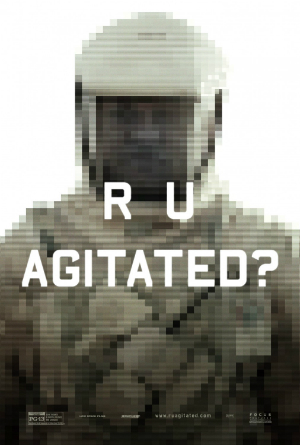 |
Though its minimalist, enigmatic marketing might suggest that The Signal – not to be confused with the zombie movie of the same name from 7 years ago – is an artsy, difficult movie, the reality is that it contains a pretty major swerve, and is ultimately one of the most rewarding sci-fi pleasures of the moviegoing year.
It begins with three friends in pursuit of a hacker named Nomad, working out their emotional issues while following a signal. But then they find a strange cabin, things go haywire, and before long we’re deep underground in a secure facility, with our hero Nic (Oculus‘ Brenton Thwaites, better here) isolated from his friends, told he’s a contamination risk, and kept in the dark about what is really going on…which as best we can tell, involves some very strange medical prosthetics.
You need to see this movie. And when I was done seeing it, I needed to talk to the man who made it. There are minor spoilers, but I tried to dance around the film’s biggest secrets.
William Eubank: Hi, man! How are you?
Luke Y: Thompson: Doing real good. I just saw the movie yesterday. I was extremely surprised! I liked it a lot. It’s one of those movies that ends up in a very, very different place than it begins. I always like that kind of journey in film.
WE: Thanks, man. I’m a big fan of that type of thing myself. That’s why it made its way up there, I guess. Where did you see it? Where were you able to go check it out?
LYT: I actually saw it at Focus’s offices in Santa Monica.
WE: Oh, very cool. So you’re based in LA?
LYT: Yeah.
WE: That’s hilarious. I find it so funny. This is sort of my first press tour I’ve ever done. I’m from LA, but now I’m on the east coast calling people in LA, so it’s kind of fun.
LYT: I guess they don’t bring the cinematographer along for most of them, do they?
WE: No, no, of course not.
LYT: What about your first film as director, Love? You didn’t tour for that at all?
WE: No. I’m in Boston right now. We did a – I forget what it’s called. It’s one of those Fathom Event things. Have you ever of that?
LYT: Yeah, yeah.
WE: We did a Fathom Event screening of Love, which was super random. We never really got a proper theatrical [release]here in the U.S., because we didn’t really ever give it to a distributor, I guess. So it had digital distribution, but we never did anything with physical.
LYT: Oh.
WE: So they just did a Fathom Event, and we did a bunch of radio promotions for it, with Angels & Airwaves being a rock band, they were in tune with that kind of promotion. So I had a couple of days of morning shows, but radio morning shows, which was really interesting. I never did a proper go-around and meet local press, or anything like that.
LYT: I was just reading up on it. The plot synopsis sounds like it has a fair bit in common with this film.
WE: Oh, yeah…
LYT: Without spoiling too much about this film.
WE: It’s pretty crazy. It’s even crazier than The Signal. It’s more like an art film. It’s my first film, it’s a $500,000 budget, with a space station I built in my parent’s back yard. It’s very – it’s like a home-grown science fiction movie, and asks a lot of questions, but maybe doesn’t answer most of them; it just sort of muses about them. But it’s cool, if you ever get a chance to check it out, it’s on Netflix, or there’s a trailer. Check out the trailer. It is definitely something that I’m proud of, since I production designed it and shot it. It’s sort of a metaphor for human connection. As a first film, it’s something that I’ll always be stoked that I did.
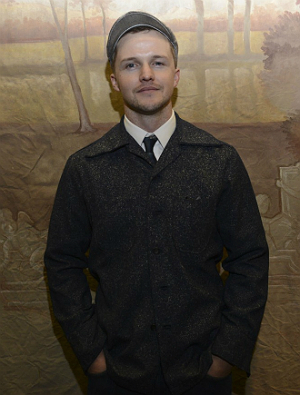 |
| Vivien Killilea/Getty Images for FOCUS Features |
LYT: Well, you could arguably say that The Signal is a metaphor for human connection as well. Do you see sort of a common theme?
WE: Yeah, yeah. For me, if I tell people Love is a movie about connection and proving that you exist, The Signal, for me, is kind of about choices and sort of what drives somebody – the decisions we make, whether we make them based off of thinking logically or thinking emotionally. Nic is sort of a character who’s being – he wants to be logical, because he believes from his computer background that that is a stronger way to live your life, and that’s a more reasonable way to live your life. Black and white decisions, yes or nos.
Then he’s sort of challenged to make an emotional choice. At the very start, he was sort of trying to push those emotions away, because he was scared of how they affected him. At the end of the movie, he chooses to embrace that emotional side and make a choice based off of a feeling. I like to think that as humans, as we get more technologically based, as tech works its way into our bodies eventually, if we’re going to make – be forced into making more logical choices, and therefore less emotional choices, does that mean that someday we’re going to be like a bunch of automatons walking around. Live for a thousand years, but eat and drink and that’s it.
LYT: Were the prosthetics in this film ever practical, or were they digital the whole time?
WE: Oh, no. Well, the legs are digital, but built off of the base of some really killer prosthetics that Legacy made – the company that made the Iron Man suit. The gauntlets and the arms – you might not even realize that those are arms – they’re arms that go over arms, they’re insane – those are all prosthetics, yeah. Really sort of wild pieces. And they actually did more than we even could show, because as prosthetics, they lit up and did all of this crazy stuff. Usually, Legacy sends a guy out who accompanies the prosthetics at all times, but we couldn’t, unfortunately, afford to get the guy. So our poor make-up people are having to learn how to do the prosthetics and do all this crazy stuff. It’s part of making a small film but with big tools, you know.
LYT: I was going to ask – did you at any point ever sketch out what an entire body of those things would look like?
WE: No, it’s funny you say that. I didn’t ever do an entire body, but my friend Jared Purrington helped me design those. I flew him out to Albuquerque, and he sat with me. I literally chained him in my room to have him do these drawings for me. He did a bunch of concept art for Superman, and he works really closely with Zack Snyder. Right now he’s out in Detroit doing storyboards for Batman vs Superman, and he’s a really sweet guy. He’s a close artist friend of mine, and we just sat there doing all these crazy sketches. I have all of these really wonderful rough drawings of other ideas.
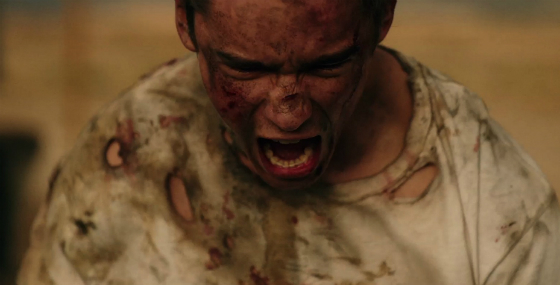 |
I just knew from a budget perspective that we couldn’t do anything organic, because that would be too complex from a visual effects world. Organic stuff is so much harder. So I knew it needed to be hard modeled, and Jared has always done these really beautiful geometric designs, and I was like, man, let’s build legs out of this kind of stuff! It was such a fun process, getting to build this stuff out, and then trying to figure out how to make it move, and how things would hinge. It really went through a weird process. So Jared and I kind of invented these looks, then we sent those to Legacy, and then Legacy computer-modeled them out. Then they actually 3-D print them with all that crazy stuff. And then from there, those models, those computer models went to Spin DFX, who did the final leg model stuff. From there, they had to really kind of re-engineer them so they could bend and move and how would they react and stuff.
Obviously, this process only happened for the legs, but it was pretty cool. I wish – Legacy owns the gauntlets, I guess. That was part of the deal. We just rented them from them. So they built them custom, but then we rented them. I wish so badly I had a pair in my office or something! I could Halloween them or something.
LYT: What are they going to do with them now? They can’t use them in anything else, unless you do a sequel.
WE: I know! I don’t know, man. There are two pairs. There’s a hard-modeled pair, and then there’s a stunt pair that are built out of foam.
LYT: You’ve just got to get some merchandising going. That way you can get some prop replicas.
WE: I know. We have to figure out – we’re in a spot right now where part of the joy of the film is obviously revealing stuff, so spoilers and stuff are kind of gnarly. We’ve already talked about a bunch of stuff. You have to decide how much you want to spoil certain things or whatever, but hopefully hiding a little bit of this stuff. But now in the marketing, it’s a question of how much do we give up? Do we give up a little bit more? I really would like to keep part of it hidden, obviously, but it just seems like to me, if there was a cool poster of a fogged-out gauntlet, you wouldn’t necessarily know what that is or what it belongs on, so it would just be more enticing to go see it.
LYT: It’s an interesting kind of dance, because I feel like it’s been marketed kind of as an art house movie so far, but there is more of a sci-fi, Twilight Zone angle to it that might appeal to other audiences that aren’t necessarily responding to the fact that it’s a Sundance movie or whatever.
WE: Yeah. Right, right, right. All of the social media is pretty aggressively scary, I want to say, right now, though, which is interesting. Like our poster doesn’t have any Sundance laurel on it. Not that that would scare anyone away, whether or not we did have it. I don’t even know – maybe we designed the poster before that, which I can’t really quite remember. But Nomad is out there tweeting right now and favoriting people’s tweets and doing crazy stuff. A lot of the pictures and stuff that he has on his Instagram, or if you follow him on Vine, there’s all kinds crazy, weird videos that are kind of disturbing. Those are all really disturbing! They’re just very crazy. You should check them out. They’re sort of weird. But almost very un-Sundance, if you ask me. Very “What the heck?” It’s kind of fun.
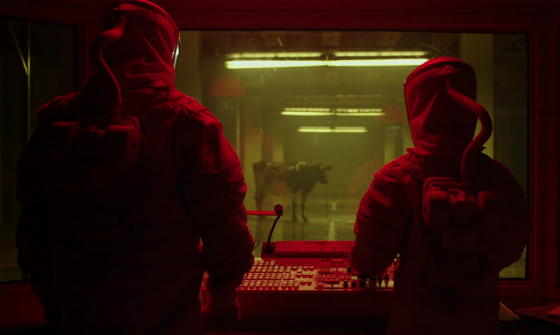 |
LYT: How many of the locations were found, and how many were constructed?
WE: Well, most of them were found. Even most of those hallways, we just repainted them and built air-locks and built parts of them, or lowered ceilings – stuff like that. But we were at a cool studio called I25 Studios in Albuquerque, New Mexico, and we basically got the whole place at first, because there wasn’t anything else shooting there. We had some stage space, and we had all these hallways. But then suddenly, out of nowhere – there’s a bigger studio there called Q Studios, which is where Breaking Bad and Terminator were shot at. Really big, crazy studios. But Wally Pfister came through, and they said, “Oh, we want to do Transcendence here.” And they took over the entire I25 studios. Suddenly we had to wear security badges and all this stuff. And then, as it turns out, they took every stage – of course – and we had a little bit of work space.
But they were like, “Great, we want this really long hallway. That’s why we came here.” And they were like, “Well, Signal has all the hallway rights.” They were like, “That’s the only reason we came here, because we love these crazy-long hallways.” So in the end, we ended up kind of bartering with Transcendence a little bit. We got some gear from them, like some fans and some crazy effects parts, and we gave up part of our shooting in one of these really long hallways, that they ended up building a set within to create a crazy-long hallway. So that was kind of fun and funny. It was crazy trying to work underneath Transcendence, and for one, feeling like the small fish in a big pond, but two, it’s kind of inspiring, because you’re watching a real big movie in action, going “Gosh, one day!”
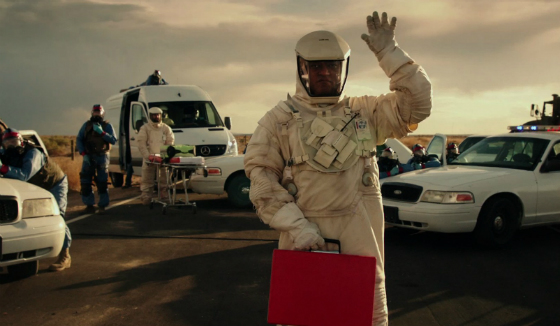 |
LYT: Interesting that you bring up fish, because that was going to lead to my next question. I’m not going to ask for a direct explanation here, but the scene where Laurence Fishburne puts another goldfish into the bowl – is that a throwaway, or is that something I should be reading more into, just in broad strokes?
WE: Well, it’s a pretty strong metaphor, talking about fish and fish bowl. It also has a little bit to do with Damon’s character. But yeah, what do fish in a fish bowl represent, and is there a mirror there to something else?
LYT: But he had that fish on his person the whole time?
WE: What’s that?
LYT: Did he have that fish on his person the whole time, in his suit?
WE: Oh, no, no! [chuckles]When he shoots the guy, the guy has a fish bowl next to him. When he shoots the guy, the guy knocks the fish bowl over, or splashes the fish out.
LYT: Oh, OK! So he was just picking the fish up and putting it back in.
WE: [chuckles]That idea is hilarious!
LYT: There was one fish in there – I thought he had somehow produced a second one.
WE: Oh, that’s so funny! I hadn’t even looked at it that way. No, the idea is he knocked the fish bowl, knocked the fish out, and Damon didn’t want the fish to die, because that was not a part of the plan, so he picks it up and puts it in the fish bowl. [laughs]That’s so funny! Wouldn’t that be funny if Laurence Fishburne had a fish on him!
LYT: Exactly! Were you aware of the other movie called The Signal, which is also a favorite of mine?
WE: You know, I was not aware of that. And obviously, that produced all kinds of crazy, weird Sundance stuff, because apparently it went to Sundance as well, and it’s a genre film, and it was – I guess it was seven years ago or something. Or 2007, correct?
LYT: Yeah, that’s about right.
WE: So yeah, obviously, that produces all kinds of, “Wait a second-what Signal are we talking about here?” But we were so deep into it that it wasn’t like we were going to change the title at this point. Shit – there’s a couple of Signals out there.
LYT: They’re very, very different movies.
WE: I have to see it. I have not watched it. Anyone I talk to who brings it up says they’re a big fan, so I’ll have to check it out.
LYT: It’s a good one. It’s also ironic, because it’s a signal that makes people homicidal, and then some guy in the screening actually did go homicidal.
WE: Oh, no! What do you mean?
LYT: Some dude in Orange County, California, just started attacking people in one of the screenings.
WE: Oh, no.
LYT: With an axe or something.
WE: Holy shit! Did anyone die?
LYT: I think it was just injuries, but it was very tragically ironic, given that that was what the movie was about.
WE: Oh, no! That’d be awful. Holy moley.
LYT: I don’t think you have to worry about moviegoers being trapped in underground facilities after seeing your movie.
WE: Yeah, right! Hopefully not.
LYT: So how did you bring Laurence Fishburne on board?
WE: You know, he, I guess, just read the script. Yeah, he picked it up, he read it, and he said, “You know what? It’s a cool story.” When I talked to him on the phone, he was like, “Look, man, when I started reading this, I couldn’t put it down. I wanted to know what was going to happen. It’s really cool.” He was like, “I want to do this.” Those are like magic words – all those were like, holy moley. I have a legend who is into doing this, so I was just – it was exciting, man. I just was like – he brought so much design to Damon suddenly. So much power and gravity to his voice and to the weight and the force that Damon was going to carry on screen, so it was a really big moment to get him. And on set, he’s such a nice guy and such a hard worker and such a good dude.
It was really like – it made us feel legitimate, you know what I mean? Even though we were a smaller film, he was there for about two weeks or whatever, and it just made us feel like we were really doing something real here. And that – when he’s on point and Brenton’s on point and all the kids are doing great, it’s really a huge confidence booster to the ranks – to the production designer and the cinematographer. Everyone’s like, “Oh, cool! We are making a cool film!”
LYT: Yeah.
WE: It was really great getting Laurence there.
LYT: Did you conceive the character in your head as being anything vaguely Morpheus-like? There’s a little bit of commonality, and then you bring him, and it automatically kind of gets there.
WE: The total truth is, I always imagined initially – the honest, honest truth – I always imagined Damon being a little more Anton Chigurh.
LYT: From No Country for Old Men.
WE: Yeah. You write a vision in your head, and that’s what you’re thinking. But when it became Laurence – you have to, especially on a smaller film – it’s all like drunken-monkey fighting. Everything’s adaptation. Beau was written as an entirely different character as well – Jonah was. When something becomes more real in a different way, you need to embrace it quickly and make that even – because it becomes better that way.
LYT: Yeah.
WE: So having Laurence take this role and embrace this, and watch him create this character was such a treat. There was no – I never – as soon as we cast him, I knew Damon was going to be different than I initially envisioned him, but he was going to be even more powerful, the way we were going to get him. It was great.
LYT: Did you always want to be a director when you started off as a cinematographer, or was cinematography your first love?
WE: Oh, yeah. Without a doubt. I mean, I literally had no connections in the industry. I had no way of getting in, I didn’t get into film school at UCLA. I tried to – it didn’t happen. I went to Brooks Institute of Photography. I had no way of breaking in. So the only thing I could think of was to go learn the cameras, figure out how to shoot stuff, and then try to direct my own stuff. Then basically, I would direct stuff every weekend, like little fake shorts, or I would do little spec commercials while I was working at Panavision as a camera tech, learning the digital stuff.
I built a little editing system well before data drives that were out that could capture 1920 by 1080 stuff, and I remember the digital guys at Panavision being like, “Holy crud! This kid has a computer that can digest – a person computer that can pull in HD footage.” I had 17 hard drives stacked on top of each other with a loaner card from Black Magic Design. It was so crazy, man – I can’t even tell you.
But I was just, at the time, trying to gather all the information I could about the tools. And that basically led to me being around cameras so long that I started to use the cameras – and I owe everything to Panavision – I started to use the cameras as leverage to get jobs. I would say, “Hey, I’ll shoot your thing if you let me be the cinematographer. I have some cameras from Panavision.” People would be like, “Oh, yeah, OK-great!” Like, “We don’t know if you can shoot anything, but you have cameras, so great.” [laughs]
So I was using that as a foot up to keep working and keep developing, and waiting until somebody was going to come along and say “I’m want to give you some money to make a movie.” And then that came in the form of Tom DeLonge from Angels & Airwaves, eventually. He gave me the money to make the movie Love. So yeah, the cinematography part was always just trying to – it was a careful calculation, in terms of how do you get somewhere? What’s the road map?
LYT: When I see a movie like this, I sort of think about Duncan Jones making Moon and then going to Warcraft, and then Gareth Edwards Monsters, and then going to Godzilla. Has this opened any doors, and are you taking meetings for bigger stuff, now that people see you can do the big ideas?
WE: Yeah, you have to know – I’m always writing stuff, and hopefully some of my bigger ideas I’ll be able to modestly keep increasing budgets and keep moving up. Definitely doing the meetings and stuff. It’s not like somebody has come out of nowhere and said “You’re going to go direct this or that.” But definitely there’s a lot of cool – this movie has brought a lot of great energy my way, and – I don’t know, I desperately want to get some of my other stories out. I feel like I have so many stories, I won’t make them all before I die. But hopefully, I can kind of continue to make my strange, crazy shit!
But yeah, we’ll have to see. I have a few different things in the works. They’re not all sci-fi. One’s a military, sort of a lost innocence, but sort of contained, during warfare. Another is sort of a Scottish, crazy film – a little bit of Braveheart, a little bit of Miyazaki madness. Sort of a fantasy film, I guess you could say. So I don’t know – I have a bunch of weird stuff, and we’ll have to see if I can keep making my stuff. And in the meantime, if an opportunity comes along to do something great, my ears are to the tracks. We’ll have to see what happens.
LYT: If The Signal does well enough, can you see where that might go into further exploring that world?
WE: Aww, man, I would love to! Obviously, there are some unanswered things that could only be answered in a sequel, but you never know. We will have to see what happens. I would love to revisit a couple of these characters down the road, and show the world that Damon lived in. That would be so much fun.
—
The Signal opens Friday.

